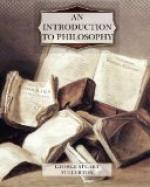From Locke’s position to that of Berkeley was a bold step, and it was much criticised, as well it might be. It was felt then, as it has been felt by many down to our own time, that, when we discard an external world distinct from our ideas, and admit only the world revealed in our ideas, we really do lose.
It is legitimate to criticise Berkeley, but it is not legitimate to misunderstand him; and yet the history of his doctrine may almost be called a chronicle of misconceptions. It has been assumed that he drew no distinction between real things and imaginary things, that he made the world no better than a dream, etc. Arbuthnot, Swift, and a host of the greater and lesser lights in literature, from his time to ours, have made merry over the supposed unrealities in the midst of which the Berkeleian must live.
But it should be remembered that Berkeley tried hard to do full justice to the world of things in which we actually find ourselves; not a hypothetical, inferred, unperceived world, but the world of the things we actually perceive. He distinguished carefully between what is real and what is merely imaginary, though he called both “ideas”; and he recognized something like a system of nature. And, by the argument from analogy which we have already examined (section 41), he inferred the existence of other finite minds and of a Divine Mind.
But just as John Locke had not completely thought out the consequences which might be deduced from his own doctrines, so Berkeley left, in his turn, an opening for a successor. It was possible for that acutest of analysts, David Hume (1711-1776), to treat him somewhat as he had treated Locke.
Among the objects of human knowledge Berkeley had included the self that perceives things. He never succeeded in making at all clear what he meant by this object; but he regarded it as a substance, and believed it to be a cause of changes in ideas, and quite different in its nature from all the ideas attributed to it. But Hume maintained that when he tried to get a good look at this self, to catch it, so to speak, and to hold it up to inspection, he could not find anything whatever save perceptions, memories, and other things of that kind. The self is, he said, “but a bundle or collection of different perceptions which succeed each other with inconceivable rapidity, and are in a perpetual flux and movement.”
As for the objects of sense, our own bodies, the chairs upon which we sit, the tables at which we write, and all the rest—these, argues Hume, we are impelled by nature to think of as existing continuously, but we have no evidence whatever to prove that they do thus exist. Are not the objects of sense, after all, only sensations or impressions? Do we not experience these sensations or impressions interruptedly? Who sees or feels a table continuously day after day? If the table is but a name for the experiences in question, if we have no right to infer material things behind and distinct from such experiences, are we not forced to conclude that the existence of the things that we see and feel is an interrupted one?




